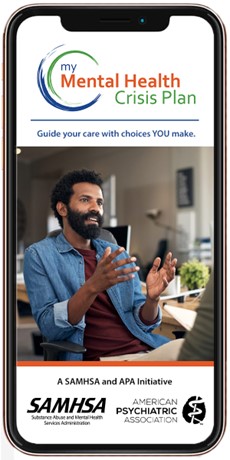Putting a Care Plan in Place Before a Mental Health Crisis
A Psychiatric Advance Directive (PAD) can be useful tool to help people with serious mental illness plan ahead and have more control over their treatment during a time of crisis. However, they can only be effective when they are prepared in advance and implemented when needed. A PAD (sometimes called a mental health advanced directive) is a legal document that includes a list of instructions and preferences that the individual wishes to be followed in case of a mental health crisis.

A new app is designed to help make the process easier and more accessible. The My Mental Health Crisis Plan app was developed by SMI Adviser, an initiative administered by the American Psychiatric Association (APA) and funded by the Substance Abuse and Mental Health Services Administration (SAMHSA).
PADs are different than medical advance directives, which may be more familiar to many. Medical advance directives focus on end-of-life care and withholding treatment; PADs allow individuals to state their mental health care preferences and provides them a voice in their care choices when they may not be able to give informed consent.
Despite their potential usefulness, few patients complete PADs, according to a recent report published in Psychiatric Services, an APA journal. Researcher Jessie Lenagh-Glue, M.A., L.L.B., and colleagues identified several barriers to completing PADs, including
- lack of a defined process for creating a PAD
- lack of suggestions or prompts to the individual regarding items to include in the PAD
- pessimism about the usefulness of the PAD process and the value of its likely outcomes
- mistrust between clinicians and patients regarding implementation
The study also looked at factors that supported the development of PADs. They found PADs were most often completed with the assistance of a caseworker, typically a nurse, and that targeted education and training for all interested parties can help address misunderstandings and support people in creating PADs. Having an individual within the healthcare organization who advocates for the use of PADs and helps to overcome challenges was also helpful.
The study concludes that the “most important factor appeared to be that individuals creating PADs do so with the help of someone whom they trust and with whom they feel comfortable.”
The new My Mental Health Crisis Plan mobile app allows individuals who have serious mental illness to create a plan to guide their treatment during a mental health crisis. It provides a step-by-step process to create and share a PAD, including:
- Clearly state preferences for treatments, such as medications (to use and those not to use); preferences for hospitals; and preferences for doctors and other mental health professionals.
- Decide who can act on their behalf by designating a trusted person (sometimes referred to as “health care agent,” “proxy,” or “health care power of attorney”) as a decision-maker on their behalf.
- Identify who should be notified in the event they experience a mental health crisis.
- Share the plan with others, including doctors, other members of the care team, and family and friends.
Regulations around the use of PADs vary from state to state and the app includes state-specific requirements for completing the PAD (such as signatures, witnesses, notary public). It also allows the PAD to be shared via PDF or QR code with whomever an individual chooses.
My Mental Health Crisis Plan app is available in the Apple App Store and Google Play. View videos on What is a PAD? and How to Use the App. View more information at: http://SMIadviser.org/mymhcp.
References
- Lenagh-Glue, J. et al. Help and Hindrances to Completion of Psychiatric Advance Directives. Psychiatric Services, Online October 2020.
- SMI Adviser - SMIadviser.org
